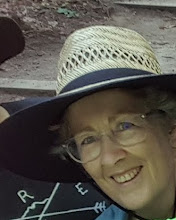
What better way to end the week than to let the kids play in the dirt. Six million year old dirt. With fossils.
At the eastern most tip of Beaufort County lies the tiny town of Aurora, home to a massive phosphate mine. While largely unknown to the rest of the state, researchers from around the globe visit this tiny town to see what the phosphate folks are digging up. Teachers come too, along with the occasional fossil afficionado tourist. For their pleasure and reward, each week the mine owners dump a load of fossil-laden mine tailings (quaintly referred to as "reject") in a pile across the street from the Aurora Fossil Museum, the town's sole attraction. Maddie makes a pilgrimage to Aurora once a year to fill these three plastic buckets for a day of learning and fun with the 8th grade science class. This is her favorite lesson to teach, and despite spending weeks in a foot cast after twisting her ankle on this last trek, she sounded ready to head back for next year's stash.
 This past year she brought her elderly mother along who had so much fun dirt-digging she refused to leave until she'd filled the pockets of her housecoat. (Apparently Maddie comes by this love honestly. ) The kids felt this way, too. As soon as she'd dumped a large coffee mug of reject before each student they were into it. And almost immediately you could hear the oohs and aahs of discovery. Twice she'd have students stand up and switch piles with someone else. And with each switch, there were new discoveries.
This past year she brought her elderly mother along who had so much fun dirt-digging she refused to leave until she'd filled the pockets of her housecoat. (Apparently Maddie comes by this love honestly. ) The kids felt this way, too. As soon as she'd dumped a large coffee mug of reject before each student they were into it. And almost immediately you could hear the oohs and aahs of discovery. Twice she'd have students stand up and switch piles with someone else. And with each switch, there were new discoveries. This lesson is part of a collaborative project with one of the 8th grade science teachers. Each student received a pictoral guide, a zip lock bag, a mug of dirt, and lots of encouragement. Even the teacher couldn't keep her fingers away from the stuff. Maddie began the lesson with a map of NC counties and a quick geography lesson to orient students to the reject's source. She also had a dataprojector set up to explore the fossil museum web page. She used audio/visual aids, textual information, and tactile engagement to anchor the lesson and address multiple learning styles. Switching tables gave the students a chance to stretch and move with a purpose. They were encouraged to speak softly with one another to collaborate on identifying their "finds". And their science teacher assessed them on their participation and deportment. Sure seemed like an A+ lesson plan to me!
This lesson is part of a collaborative project with one of the 8th grade science teachers. Each student received a pictoral guide, a zip lock bag, a mug of dirt, and lots of encouragement. Even the teacher couldn't keep her fingers away from the stuff. Maddie began the lesson with a map of NC counties and a quick geography lesson to orient students to the reject's source. She also had a dataprojector set up to explore the fossil museum web page. She used audio/visual aids, textual information, and tactile engagement to anchor the lesson and address multiple learning styles. Switching tables gave the students a chance to stretch and move with a purpose. They were encouraged to speak softly with one another to collaborate on identifying their "finds". And their science teacher assessed them on their participation and deportment. Sure seemed like an A+ lesson plan to me!



No comments:
Post a Comment